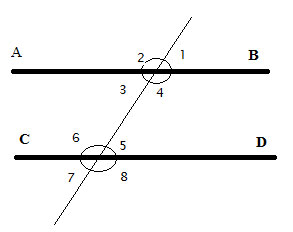The Theorem
The Consecutive Interior Angles Theorem states that the two interior angles formed by a transversal line intersecting two parallel lines are supplementary (i.e: they sum up to 180°).

The problem
AB||CD, prove m∠5 + m∠4 = 180°, and that m∠3 + m∠6 = 180°
So how do we go about this? We already know that the two angles that are next to each other and which form a straight line are “Supplementary angles” and their sum is 180°. So we will try to use that here, too, since here we also need to prove that the sum of two angles is 180°.
So let’s proceed to the proof, using what we already know about
Proof
Here's how you prove the Consecutive Interior Angles Theorem:
(1) AB||CD //given
(2) ∠1 ≅ ∠5 //from the axiom of parallel lines – corresponding angles
(3) m∠1 = m∠5 //definition of congruent angles
(4) m∠1 + m∠4 = 180° //straight line measures 180°
(5) m∠5 + m∠4 = 180° //using (3) and (4), and performing algebraic substitution, replacing m∠1 with the equivalent m∠5
And we can repeat this proof for the second pair of interior angles. We'll replace m∠1 with m∠2, m∠5 with m∠6 and m∠4 with m∠3
And we have proven the theorem.
